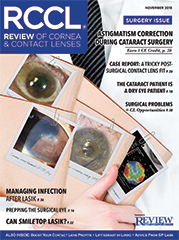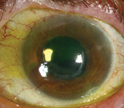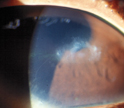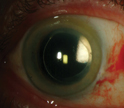
Supplement to
| NEWS |
|
Check out more articles from the November issue of RCCL here! |
My Perspective: Generic Drugs: More than Meets the Eye? Lens Care Insights: Never-ending Story Pharma Science & Practice: Lifitegrast in Limbo Out of the Box: Reach Out Corneal Consult: When the Going Gets Tough Practice Progress: New Kid on the Block The GP Expert: Playing the Field: How Manufacturers Can Help You Features: Supercharge Your Contact Lens Profitability Prepping the Surgical Eye The Cataract Patient is a Dry Eye Patient Something to SMILE About? Staying in Shape: Post-Surgical Keratoconic Lens Placement Corneal Astigmatism Correction During Cataract Surgery
|
| Have a topic you want to see discussed? Want to comment on an article? We want to hear from you! Contact us with your feedback and suggestions. |
20 Pearls on Surgical Comanagement The optometrist’s role in comanagement of cataract and refractive surgery has expanded beyond mere screening and referral to active engagement in pre- and post-op care. And the line between these two previously distinct surgeries continues to blur as the refractive component becomes more central to patient expectations following cataract surgery. To help optometrists meet surgical challenges both old and new, the November issue of Review of Cornea & Contact Lenses is devoted to exploring these responsibilities. Below are 20 pearls shared by experts in the field. For more detail, click through to read the original articles for each. |
|
| 1. Ocular surface disease disproportionately affects cataract patients. One study found that 62.9% had a tear break-up time of less than five seconds, 76.8% showed positive corneal staining, 50% showed central corneal staining, 48.5% had a Shirmer score of 10 or less, and 58 eyes (21.3%) scored less than five. More
| |
| 3. Prior to surgery, evaluate tear film composition and meibomian gland status. A tear concentration with greater than average mOsm/L and elevated matrix metalloproteinase inflammatory mediators can indicate an abnormal ocular surface environment, while use of a transilluminator can reveal the level of meibum quality and gland integrity. More |
| 4. Surgeons reduce astigmatism of less than 1.0D during cataract surgery by positioning the cataract incision on the steep axis to induce wound flattening, which results in a decrease in cylinder. Complications include difficulty placing the incision at certain axes in patients with prominent brow or nasal ridges and unpredictable healing of the incision. More
| |
| 5. Post-refractive surgery patients with residual refractive error may benefit from large diameter, reverse geometry GP lenses, which allow for complete vaulting of the central cornea, enhance patient comfort, and improve centration and visual acuity. More
| |
| 6. Efficacy rates for the small-incision lenticule extraction (SMILE) procedure—which eliminates the excimer laser—have demonstrated that 95% of eyes achieve at least 20/30 uncorrected distance visual acuity at three months for even moderate to high myopia levels. Refractive stability is typically achieved at one week. More
|
|
|
|
| 8. Patients with compromised corneas can be especially sensitive to debris build-up under a contact lens, and dryness and discomfort with increased wearing time, particularly when blinking is reduced while performing prolonged near tasks. Thus, always be proactive about ocular allergies in post-surgical patients, as they have an especially difficult time tolerating allergic compromise. More
| |
| 9. Blepharitis is a common pre-surgical concern. Treat inflammatory blepharitis using topical antibiotics like topical azithromycin and/or topical antibiotic/steroid combinations, or both, in addition to lid hygiene regimens. Treat infectious Staphylococcus with an antibiotic ophthalmic ointment or drop to prevent continued issues. Use steroids to help decrease inflammation. More
| |
| 10. Begin your pre-op exam with the external ocular adnexa. Look for any redness of the face or periorbital area, rhinophyma or other classic signs of rosacea. Perform a gross examination of the periorbital area to identify any lid dermatochalasis that might cause functional limitations on vision. More
| |
| 11. When evaluating patients postoperatively, evaluate refractive success in quarter-diopter steps rather than single-diopter steps to ensure good visual acuity. More
| |
| 12. Take type of procedure into account when evaluating a patient for postoperative dry eye—for example, in the case of the Kamra corneal inlay, dryness on the central aspect of the cornea is most detrimental to the patient’s refractive success and should be aggressively managed. More
|
|
| |
| 14. When planning astigmatism correction during a cataract procedure, surgeons will consider the magnitude and axis of the astigmatism, corneal pachymetry, incision location, degree of irregular or asymmetric astigmatism, desired entry site, corneal pathology, patient age and status of the fellow eye. More
| |
| 15. A rotated toric IOL will require realignment as soon as possible due to the possibility of adhesions forming between the capsular bag and IOL. More
| |
| 16. The all-femto SMILE refractive surgery is less invasive than excimer procedures and removes the possibility of flap dislocation. The cornea inherently maintains a greater biomechanical structure and fewer corneal nerves are incised; as a result, a lower frequency of dry eye complaints and a shorter healing cycle are expected. More
| |
| 17. Research has shown fish oil containing eicosapentaenoic and docosapentaenoic polyunsaturated fatty acids and omega-3 fatty acids may reduce inflammation and increase tear production. Consider advising patients with dry eye to take high-dose capsules containing omega-3 and omega-6 fatty acids on a daily basis beginning one month before surgery to help maintain the tear film. More
| |
| |
|
| |
| 19. Because SMILE is completed intrastromally, it eliminates environmental influences found in LASIK and PRK—i.e., air purity, humidity, barometric pressure and temperature of the operating room—that can affect the photoablation ability of the excimer beam and the amount of dry cornea removed with each pulse. This explains why a -10D treatment is just as predictable as a -1D treatment with SMILE. More
| |
| 20. In determining the power and meridian of a toric IOL, the surgeon will take into account the vector sum of the preexisting corneal astigmatism and surgically induced astigmatism. Other factors that affect post-op uncorrected acuity are effective lens position and the spheroequivalent power of the IOL on the effective toricity of the IOL at the corneal plane. More | |
|
| |
| |




